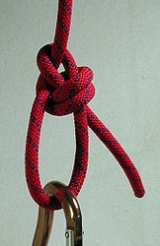
Double bowline
Encyclopedia
A double bowline is a type of loop knot
. Instead of the single turn of the regular bowline
, the double bowline uses a round turn. This forms a more secure loop than a standard bowline. The Bowline on a bight
, when re-threaded instead of being tied on a bight, can also be used for tying into a climbing harness and provides more strength and security than the double bowline.
, this name is also reasonably descriptive of a different knot: the bowline on a bight
. Because of this ambiguity
some sources differentiate by using one of the alternate names above. And at least one other source uses the name "double bowline" for a mid-line loop knot made by tying a basic bowline with a bight
of rope instead of the end.
, along with the Figure eight loop. The advantage of the double bowline over the figure 8 is it is easier to untie after being weighted in a fall.
The double bowline is commonly used by sport climbers who take multiple lead falls and then have trouble untying their figure eights. The disadvantage of the double bowline is that it is less secure than a figure eight knot.
Knot
A knot is a method of fastening or securing linear material such as rope by tying or interweaving. It may consist of a length of one or several segments of rope, string, webbing, twine, strap, or even chain interwoven such that the line can bind to itself or to some other object—the "load"...
. Instead of the single turn of the regular bowline
Bowline
The bowline is an ancient and simple knot used to form a fixed loop at the end of a rope. It has the virtues of being both easy to tie and untie. The bowline is sometimes referred as King of the knots because of its importance...
, the double bowline uses a round turn. This forms a more secure loop than a standard bowline. The Bowline on a bight
Bowline on a bight
The Bowline on a bight is a knot which makes a pair of fixed-size loops in the middle of a rope. Its advantages are that its loops do not slip and it is reasonably easy to untie after being exposed to a strain. This knot can replace the figure-eight knot when tying into a climbing harness...
, when re-threaded instead of being tied on a bight, can also be used for tying into a climbing harness and provides more strength and security than the double bowline.
Naming
Though called "double bowline" by Clifford AshleyClifford Ashley
Clifford Warren Ashley was an American artist, author, sailor, and knot expert. He was born in New Bedford, Massachusetts, son of Abiel Davis Ashley and Caroline Morse. Ashley married Sarah Scudder Clark in 1932 and had two daughters, also adopting his wife's oldest daughter from a previous...
, this name is also reasonably descriptive of a different knot: the bowline on a bight
Bowline on a bight
The Bowline on a bight is a knot which makes a pair of fixed-size loops in the middle of a rope. Its advantages are that its loops do not slip and it is reasonably easy to untie after being exposed to a strain. This knot can replace the figure-eight knot when tying into a climbing harness...
. Because of this ambiguity
some sources differentiate by using one of the alternate names above. And at least one other source uses the name "double bowline" for a mid-line loop knot made by tying a basic bowline with a bight
Bight (knot)
In knot tying, a bight is a curved section, slack part, or loop between the two ends of a rope, string, or yarn. The term is also used in a more specific way when describing Turk's head knots, indicating how many repetitions of braiding are made in the circuit of a given knot.-Slipped knot:In order...
of rope instead of the end.
Tying
First, learn to tie the bowline by laying the working end on the standing part and twisting to form a loop (the "hole" that the rabbit comes out of). Wrap the loop once more around the working end. Then pass the working end behind the standing part and back down through the double loop.Uses
The double bowline is one of two typical tie-in knots used in climbingClimbing
Climbing is the activity of using one's hands and feet to ascend a steep object. It is done both for recreation and professionally, as part of activities such as maintenance of a structure, or military operations.Climbing activities include:* Bouldering: Ascending boulders or small...
, along with the Figure eight loop. The advantage of the double bowline over the figure 8 is it is easier to untie after being weighted in a fall.
The double bowline is commonly used by sport climbers who take multiple lead falls and then have trouble untying their figure eights. The disadvantage of the double bowline is that it is less secure than a figure eight knot.

